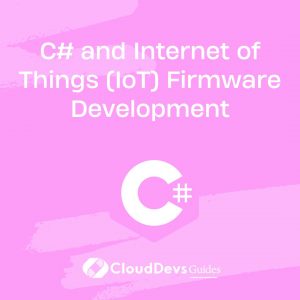C# and Internet of Things (IoT) Firmware Development
Table of Contents
The Internet of Things (IoT) has revolutionized the way we interact with technology, connecting everyday devices to the internet and enabling intelligent solutions. Firmware development for IoT devices requires a language that offers performance, reliability, and easy integration with hardware. C# stands out as a versatile choice for IoT firmware development, especially with the advancements in the .NET ecosystem. This article explores how C# can be effectively utilized for developing IoT firmware, providing practical examples and strategies.

Understanding IoT Firmware Development
Firmware is the low-level software that provides control and communication between hardware and higher-level software. In IoT, firmware development involves creating software that runs on embedded systems, managing device operations, and ensuring seamless communication with other devices or cloud services.
Using C# for IoT Firmware Development
C# offers several advantages for IoT firmware development, including a rich set of libraries, strong integration with .NET, and support for modern programming paradigms. Below are key aspects of using C# for IoT firmware development, along with practical examples.
1. Setting Up a Development Environment
Before diving into coding, setting up a development environment is crucial. Visual Studio provides excellent support for C# development, including tools for managing and debugging IoT projects.
Example: Configuring a C# IoT Project in Visual Studio
- Open Visual Studio.
- Select “Create a new project.”
- Choose “Console App” and select C#.
- Name your project and click “Create.”
2. Communicating with IoT Devices
C# provides libraries and APIs to facilitate communication with IoT devices. For example, you can use the `System.IO.Ports` namespace for serial communication.
Example: Reading Data from a Serial Port
```csharp
using System;
using System.IO.Ports;
class Program
{
static void Main()
{
using (var serialPort = new SerialPort("COM3", 9600))
{
serialPort.Open();
while (true)
{
string data = serialPort.ReadLine();
Console.WriteLine($"Received data: {data}");
}
}
}
}
```
3. Managing Device State and Operations
Efficiently managing the state and operations of IoT devices is crucial. C#’s object-oriented approach and async programming features are beneficial for managing these aspects.
Example: Implementing Device State Management
```csharp
using System;
using System.Threading.Tasks;
class Device
{
public bool IsActive { get; private set; }
public async Task ToggleStateAsync()
{
IsActive = !IsActive;
await Task.Delay(500); // Simulate a delay
Console.WriteLine($"Device state changed: {(IsActive ? "Active" : "Inactive")}");
}
}
class Program
{
static async Task Main()
{
var device = new Device();
await device.ToggleStateAsync();
await device.ToggleStateAsync();
}
}
```
4. Integrating with Cloud Services
Cloud integration allows IoT devices to send data to and receive commands from cloud platforms. C# can be used to interface with various cloud services using libraries such as `Azure.Messaging.EventHubs` for Microsoft Azure.
Example: Sending Data to Azure IoT Hub
```csharp
using Azure.Messaging.EventHubs;
using System;
using System.Text;
using System.Threading.Tasks;
class Program
{
static async Task Main()
{
string connectionString = "your-iot-hub-connection-string";
string eventHubName = "your-event-hub-name";
var client = new EventHubProducerClient(connectionString, eventHubName);
var eventData = new EventData(Encoding.UTF8.GetBytes("Sample IoT data"));
await client.SendAsync(eventData);
Console.WriteLine("Data sent to IoT Hub.");
}
}
```
5. Handling IoT Device Security
Security is paramount in IoT firmware development. C# provides libraries for encryption and secure communication to protect IoT devices from threats.
Example: Encrypting Data with AES
```csharp
using System;
using System.Security.Cryptography;
using System.Text;
class Program
{
static void Main()
{
string textToEncrypt = "Sensitive IoT Data";
using (var aes = Aes.Create())
{
aes.Key = Encoding.UTF8.GetBytes("your-32-byte-key-here");
aes.IV = Encoding.UTF8.GetBytes("your-16-byte-iv-here");
var encryptor = aes.CreateEncryptor(aes.Key, aes.IV);
var encrypted = Encrypt(textToEncrypt, encryptor);
Console.WriteLine($"Encrypted data: {Convert.ToBase64String(encrypted)}");
}
}
static byte[] Encrypt(string text, ICryptoTransform encryptor)
{
using (var ms = new System.IO.MemoryStream())
{
using (var cs = new CryptoStream(ms, encryptor, CryptoStreamMode.Write))
{
using (var sw = new StreamWriter(cs))
{
sw.Write(text);
}
}
return ms.ToArray();
}
}
}
```
Conclusion
C# offers a robust framework for developing IoT firmware, from handling device communication to integrating with cloud services and ensuring security. By leveraging C#’s capabilities, developers can build efficient, secure, and scalable IoT solutions. Embracing these practices will enhance your IoT development efforts and contribute to creating intelligent and connected devices.



